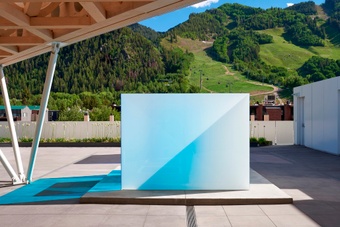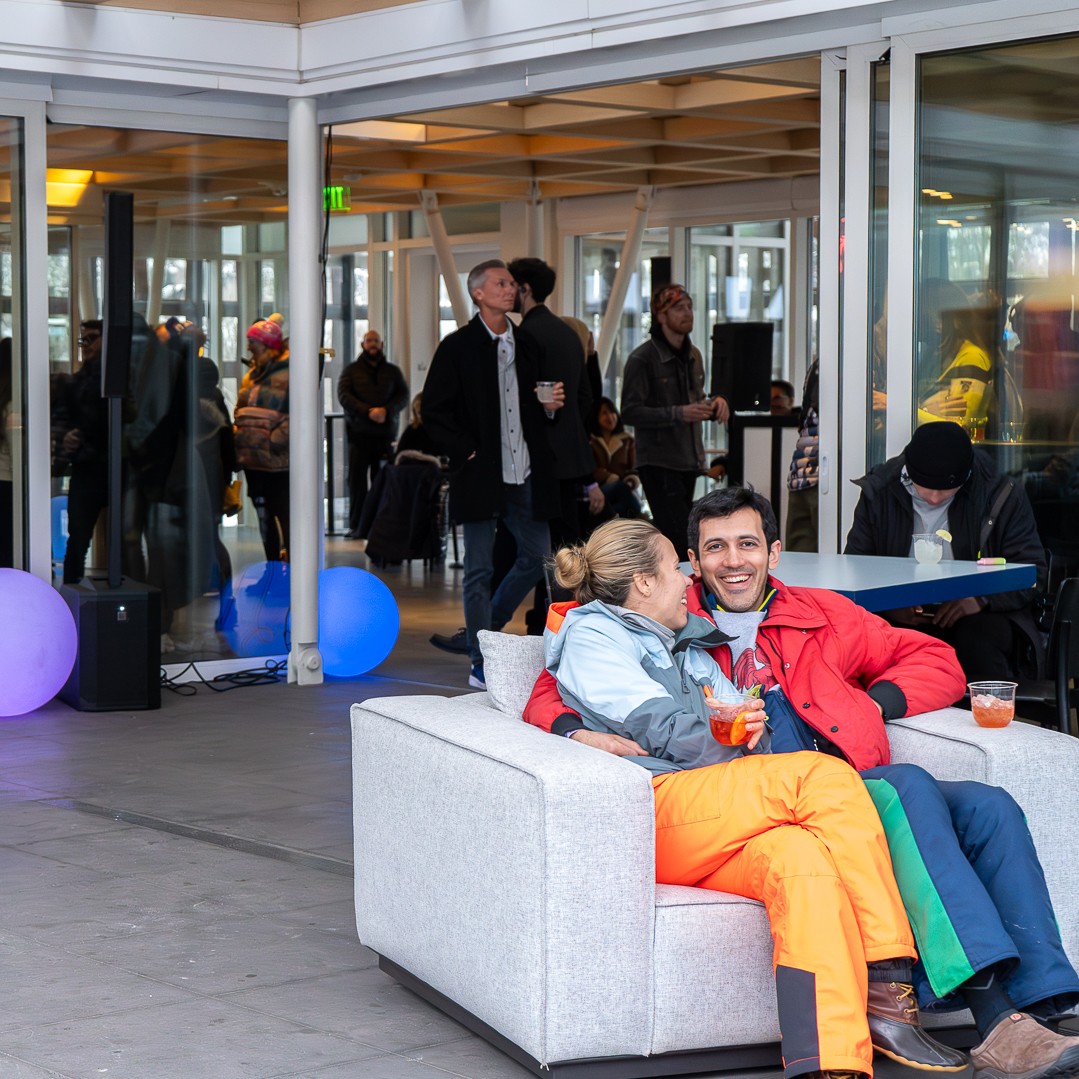Aspen Art Museum
- Join us on May 15 for engaging presentations by our esteemed 2024 Artist Fellowship recipients!
- Categories
- All events
- Talks and Lectures
- Member Events

- For more information on how you can join the AAM, please visit the Street Level Visitor Information Desk, inquire in the Shop, or call 970.925.8050.

- The Rooftop Café is committed to sharing real farm-to-fork experiences with the Roaring Fork Valley. Visit us today!

- Aspen Art Museum is an artist-founded institution dedicated to supporting artists in the development of bold ideas to shape our museum and the field of art today.
Nairy Baghramian
2023 Aspen Award for Art
Levity and Gravity
Every part has a role to play in Nairy Baghramian’s work. Although she is very much a sculptor, a recent recipient of both the prestigious Nasher Prize and the Metropolitan Museum in New York’s 2023 facade commission, she is deeply attuned to performance and thinks in groupings, even within a single work. Showing contingency as well as contradiction is part of her method. This is apparent in the construction of the works—in her various techniques of casting, molding, carving and joining, and in her formal language of bends, droops, arcs and blobs. It’s also there, sometimes indirectly, in the titling of her works or exhibitions, which always in some way anticipate and respond to the conditions of their setting and the dynamic unraveling of perspective an audience brings. “Grouping” is Baghramian’s chosen word. She prefers it to “series” or “collaboration”—no forced harmony. A grouping can be an ongoing body of work, like the large, colorful polyurethane and silicone Sitzengebliebene/ Stay Downers (2016–), or a selection of works for a specific exhibition. It can also describe Baghramian’s relationships with other artists, including the interior designer Janette Laverrière, the contemporary choreographer Maria Hassabi, the midcentury architect Carlo Mollino, or the modernist writer Jane Bowles.
Their work might appear in or alongside Baghramian’s own work—in her forms or titles, or when she turns a solo into a group show. In the case of Laverrière, Baghramian found what is still the only monograph of her work in a bookshop in New York in 2007. In it was a photograph of Laverrière’s work, Entre Deux Actes: Loge de Comédienne—Between Two Acts: An Actress’s Dressing Room, a collection of furniture she presented at a design salon in Paris in 1947, designed for her friend, a professional singer, who had suddenly stopped performing, left Paris altogether, and disappeared. After learning that Laverrière was still alive and living in Paris at the age of 98, Baghramian traveled to meet her. The two began an intense and productive dialogue that evolved into ideas for new work, and when Baghramian was asked to do an exhibition at the Kunsthalle Baden-Baden in Germany, she invited Laverrière to restage Entre Deux Actes. She later called their partnership a “co-existence”. The new version of Entre Deux Actes II—Loge des Comédiennes (2009) was an installation by way of impression. Each original piece was either reduced to its bare structure or cursorily exaggerated like shapes in a dream. The colors were inverted and shadows solidified, using logics of memory and afterimage. The reimagined work felt improvisational and playful: a tiger skin rug was replaced by a chalk outline. Baghramian’s work is never funny ha-ha, but it has an incredible way with irony, sharp in the way that history is—tragedy not excluded.
In the original Entre Deux Actes, Laverrière gives her friend one more appearance, a private moment of space and time, in the form of an ensemble. In the restaged work, there’s still no body there. But the missing actress re-finds her audience in a new, uneasy context, and Laverrière and Baghramian work up complicated dynamics of disappearance and presence with a group of elements as forms of life. How can a work be not like itself? I’m trying to identify some irreducible element of Baghramian’s practice that is to do with relationships. She herself has titled more than one exhibition ménage. At Performa 19 in New York, Baghramian staged Entre Deux Actes (Ménage à Quatre) (2019) for which she installed the actress’s reimagined quarters along with Mollino’s erotic Polaroids, and a durational work by Hassabi where the dancers got very close but never touched. Their co-existence relied on a micron of autonomy. The dictionary definition of ménage is household, which also says a lot about desire and sublimation, about split infinitives and trust. That there is never just one body in Baghramian’s work is maybe clear by now. She often uses the example of doing away with the “to-scale” individual used in architectural models. Harder to account for is that there’s every body and there’s no body. Even when a work—bent over in sections of mottled pink and white marble reinforced by cast stainless steel—is called Knee and Elbow (2020), Baghramian’s approach to the body is figural rather than figurative: about impressions and exchanges. Her complex bargains of levity and gravity, her insertion of multiple, contradictory vantages, and the almost animistic drive her work seems to have toward formal evolution, are always in service of the subtle body of sculpture rather than the human body of mind and heart.
Baghramian is conscious of display, always bringing it into the work. Frames, struts, stands or other supportive or interruptive apparatuses are often part of the grouping of a work. Sometimes the rigid or sharp or generally unyielding metal that otherwise plays a remedial role is left alone to make a structure, as in Scruff of the Neck (2016): bare, arcing lines of polished aluminum or steel intersect with one another and the wall. They leave the mind nowhere to hide. Except in the titles, which are also lacerating in some instinctual way. This feels important to spell out because of how reflexively and easily the modes and methods of collectivity in Baghramian’s practice can get softened. What looks organic is really hard, cast silicone. Baghramian works with context, not influence. She isn’t interested in collecting what she likes. She is interested in figuring difference, in making work that edges ever closer to what sculpture really is for her—a way of putting things together heterogeneously— somewhere between the audience and the object. This third body again. I can only try to make a shape around it. Both knotted ends of Treat (Marrowbone) (2016), a large wax bone, feel like fists approaching my solar plexus. The Portraits (2016), a grouping of framed C-prints or Baryte prints of billowing smokestacks, subtitled: The conceptartist smoking head, Stand-In, make “me” neither here nor there. All of these are gathered together again for “Jupon de Corps” at the Aspen Art Museum— another reconfiguration or working through of iteration, proximity, timeliness and boundaries. The universe is expanding—meaning the distance between things or the scale of space is growing. Baghramian’s universe expands via the innovative and complex ways she keeps the pieces as close as possible while holding them apart. In her first co-existence with Laverrière, La Lampe dans l’Horloge (2008), or The Lamp in the Clock, named for the Surrealist writer André Breton, Baghramian made a “room” of freestanding colorful walls for Laverrière’s iconographic mirror sculptures, or “useless objects,” inside Berlin’s Schinkel Pavillon. The “useless objects” were the designer’s last works—homages to her creative and political heroes. The walls showed the works and kept them hidden, to an extent. Baghramian was dealing with how to strike a concomitance or equality of output and energy in a cross-generational partnership, against the still-pervasive trend of recuperating “lost” practitioners in contemporary art. When she remade a version of the installation within Work Desk for the Ambassador’s Wife (2019), a posthumous show with Laverrière at Marian Goodman, she redesigned (dissolved) the walls in Plexiglass. It was still about interiority, but more in the way that air is interior to the legs of a table. Baghramian brings systems of analysis to work in order to change her own structures. It might be too much to call this infrastructural. So I will say instead that she shows the mechanics of work. Work Desk for the Ambassador’s Wife included maquettes and drawings by Baghramian that were never meant to be made into sculptures. In Modèle vivant (2022) at the Nasher Sculpture Center, Baghramian seemed to wonder what artwork might look like from an archaeological perspective—that is, dug up after it has become extinct.
New work—including enormous, fossil- or dental mold-like impressions on elaborate dark blue, green and violet powdercoated metal stands, and geometric aluminum panels suspended from the ceiling on polished stainless-steel poles, with other, coarser aluminum elements and C-prints of flies on animal skins attached—were all arranged around works from the museum’s collection. If the job of Baghramian’s sculpture was in some ways to be analogy, the historical works were asked to sincerely and somewhat anachronistically model how time changes shape. Live models. Life models. Imagine being responsible for making—or being—a model of life. Baghramian was intending something, I think, about artistic process and labor. How much can I rely on the artwork, or figure of the artist? What will she give me to help me understand? A recurring figure in the work since 2008, perhaps a counterpart to Laverrière’s actress, is the male escort, as in the exhibition, The Walker’s Day Off (2008) at the Kunsthalle Baden- Baden. He needs structural support too; he bears the weight of our demand for charm and novelty. Beauty, a currency in every sense, is a complicated part of his job. Baghramian’s studio is in an industrial part of Berlin—something she does not want to fetishize. But it is where the actual mechanics are. When she first moved to the city with her family from Iran in the mid-1980s, it was customary for new buildings to receive colloquial nicknames, like the Washing Machine or the Oyster. This is something Baghramian thinks about: the shortest distance from alien to understanding, the economy of language and images, the way form enters into circulation through experience. Her sculptures must contend with the world they inhabit, one obsessed with legibility and output. How do works so heavy and in so abstract a language stay tenable; how do they live a life rather than only gesture at one? I really believe that form and its challenges are fundamental, and I think Baghramian does too. Form is the organization of meaning; it is nimble and living. Baghramian’s ability is in part to leverage the medium of sculpture in circulating formal ideas. As she wrote in Frieze Masters magazine in 2018, “My view on the present through the lens of the past is diverted by meandering around my surroundings and my own history”. The works address the anxiety and frustration and joy of universality as well as subjectivity. They will remain possible. They and I and she and all of it are just another part.
Museum admission is
free courtesy
Amy & John Phelan
free courtesy
Amy & John Phelan
- Aspen Art Museum
- 637 East Hyman Avenue
- Aspen, Colorado 81611
- t: 970.925.8050
- f: 970.925.8054
- info@aspenartmuseum.org
Admission to the AAM is free courtesy of Amy and John Phelan
The AAM’s exhibitions and programming are FREE and accessible thanks to our members! Become a member today!
| Hours |
|
Tuesday–Sunday, 10 AM–6 PM
Closed Mondays
|
© 2024 Aspen Art Museum
General operating support is provided by Colorado Creative Industries. CCI and its activities are made possible through an annual appropriation from the Colorado General Assembly and federal funds from the National Endowment for the Arts.



General operating support is provided by Colorado Creative Industries. CCI and its activities are made possible through an annual appropriation from the Colorado General Assembly and federal funds from the National Endowment for the Arts.










